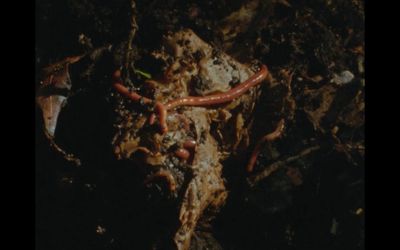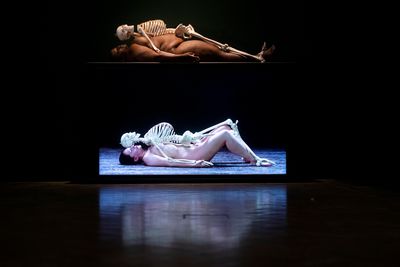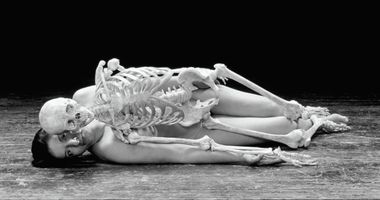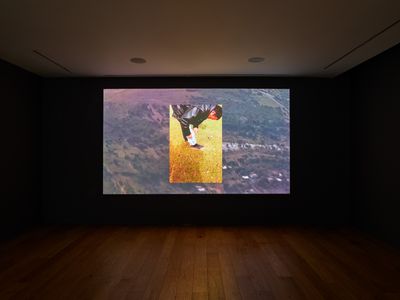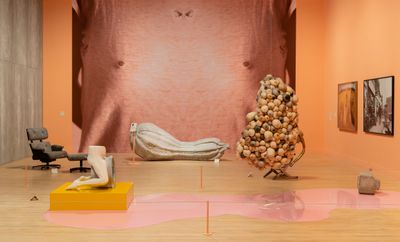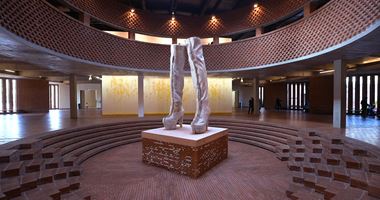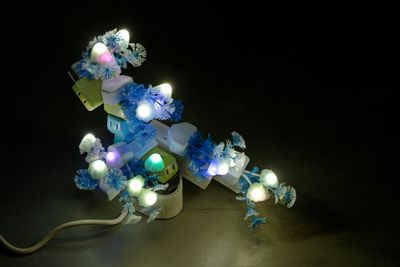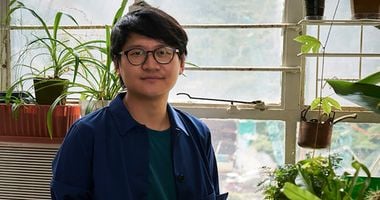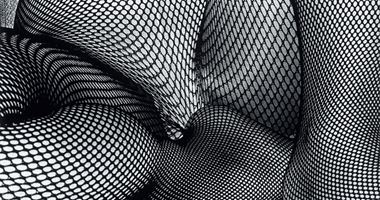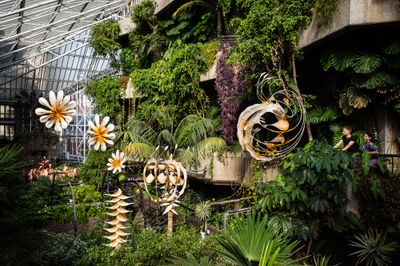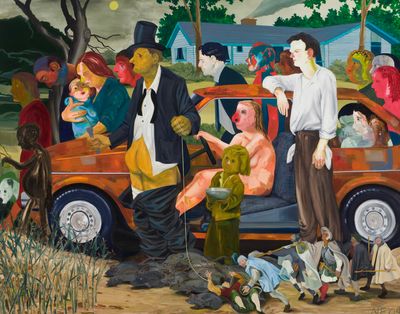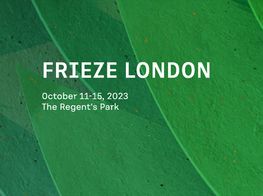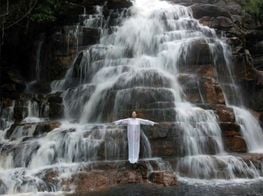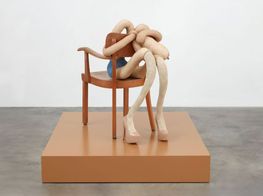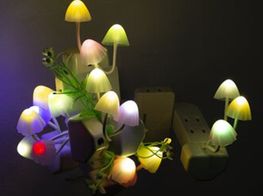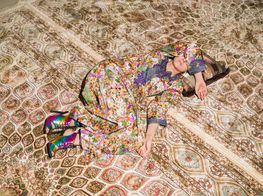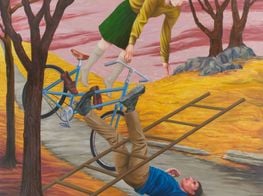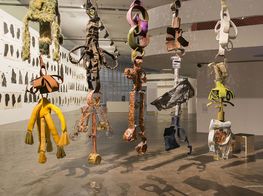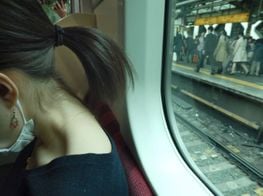London’s Best Institutional Shows, Autumn 2023

Imponderabilia (1977/2023). Live performance by Agata Flaminika and Kam Wan. 60 min. Exhibition view: Marina Abramović, Royal Academy of Arts (RA), London (23 September 2023–1 January 2024). Courtesy Marina Abramović Archives. © Marina Abramović. Photo: © RA/David Parry.
London has long dubbed itself the creative capital of the world, with more than 200 museums, 800 art galleries, and recent campaigns supported by Mayor Sadiq Khan who is looking to the art sector to 'help accelerate economic recovery'.
Launched alongside Frieze London's 20th anniversary, which returns to Regent's Park from 11 to 15 October, the 'London Creates' campaign—a public commission of graffiti reading 'art', 'love', and 'rebel' in expressive fonts—unfortunately does little to articulate the £58 million local creative industries bring in yearly.
Despite facing a £50 million national art funding cut just last year, the city's institutions remain strong. We have selected nine must-see exhibitions in London this autumn, from retrospectives of veteran artists Sarah Lucas and Marina Abramović to new commissions by Tamara Henderson, Trevor Yeung, and Farah Al Qasimi.
Tamara Henderson: Green in the Grooves
Camden Art Centre, Arkwright Road
6 October–31 December 2023
Expect: dream-toned visuals urging a renewed ecological conscience and a live audio feed of worms tunnelling through the ground.
Tamara Henderson's visual sequences rarely disappoint. Their non-sequential narratives are often devised from the artist's dream—or conceived after a hypnotherapy session inside a hotel pod at Gatwick Airport, in the case of Womb Life (2018).
In this mesmerising, grainy film, marionette-strung appliances tied to the wall with chains and rope struggle to come to life. Set inside soft, pastel-toned rooms, the action-filled scenic progression appears to relinquish all logic, evoking the magic of Disney's Fantasia (1940) with dynamic choreographies that remind us of the beauty of spontaneous processes that lie at the heart of life.
Starting from this awareness, Henderson's latest exhibition dives into earthworm ecologies to address how human interventions in the natural environment disrupt cyclical processes of degeneration and regeneration. The artist's new film commission, Green in the Grooves (2023), includes experiments made in her studio and garden in Australia, with a close-up view of knotted earthworms and vibrant greenery unearthed from stone crevasses, refracted by light.
The work follows the artist's screening of Seasons End: Out of Body at Tate Modern in 2018, a choreography of 24 frames per second. Nomadic species wearing fabric sculptures Henderson made at each location enact their evolution across California beaches and South American glaciers.
Marina Abramović
Royal Academy of Arts, Burlington House
23 September 2023–1 January 2024
Expect: original archive footage and striking re-performances of the artist's iconic works by students trained in her method.
Serbian performance artist Marina Abramović is renowned for staging tense situations that challenge the limits of the body and mind, from standing at the receiving end of a taut arrow to fasting in a gallery for 12 days, and being held at gunpoint.
Abramović breaks another boundary in 2023 as the first woman artist to be surveyed at the Royal Academy. While devoid of their original intensity, these latest performances by the veteran's students must be experienced for oneself.
The exhibition, described as 'vital' by The Guardian, begins with a re-enactment of Imponderabilia (1977) which asks audiences to squeeze between two nude performers standing in a doorway. Abramović first performed the work in a museum in Bologna in 1977 with her partner Ulay; 350 people passed between the artists before police concluded the event.
Also re-staged is The Artist is Present, Abramović's 700-hour-long seated performance at MoMA, New York, in 2010, which invited audiences to sit across from her and stare into her eyes. In Nude with Skeleton (2002), the nude artist lies on the ground with a skeleton on top of her, recreating a ritual performed by Tibetan monks.
The artist's presence spreads to Southbank Centre from 4 to 8 October, where more live performances by artists trained under her are held.
In the shade of the sun
The Mosaic Rooms, 226 Cromwell Road
6 September 2023–14 January 2024
Expect: multimedia works by a new generation of Palestinian artists seeking ways to think about Palestine.
Brought together by the 'adisciplinary' platform Bilna'es, a project by artists Ruanne Abou-Rahme and Basel Abbas, Muqata'a, and unnamed members to support artists in Palestine and beyond, The Mosaic Rooms commissioned four artists to reflect on the links between politics and aesthetics.
In Mona Benyamin's Tomorrow, Again (2023), a dysfunctional news broadcast presents segments that recreate and react to prominent daily catastrophes in Palestine. The film communicates through exaggerated emotional and physical displays, fragmented and conflicting testimonies, doppelgängers, and surrealist visuals that question the notion of truth.
Trees appear as symbols of resistance and devotion in Xaytun Ennasr's installation Revolution is a forest that the colonist can't burn (2023), which looks at establishing a 'revolutionary relationship with nature' and includes living olive and fig trees and an interactive digital game alongside drawings, textiles, and ceramics.
Layering revolutionary songs from Oman, Yemen, and Palestine with images of birdsong competition, Dina Mimi's two-chapter project, The melancholy of this useless afternoon (2023), reflects on the dynamics between fugitive and smuggler. A sound work by Makimakkuk addressing identity, colonisation, love, and relationships will be performed in a separate event (dates TBC).
Sarah Lucas: Happy Gas
Tate Britain, Millbank
28 September 2023–14 January 2024
Expect: four decades of provocative photographs and sculptures by an artist whose disregard for decorum disrupted age-old perceptions of women with wit and impertinence.
Born in London, Sarah Lucas came to public attention in the 1980s alongside the group known as the YBAs (Young British Artists). With notable members including Damien Hirst and Tracey Emin, the group became well-known for introducing controversial subject matters, appropriating materials, and creating a shock factor.
Early photographic self-portraits see Lucas in equal defiance of the male gaze. Posing with a boyish haircut and wearing a leather jacket, the artist looks toward the camera while eating a banana; in another image, she is seated with her legs spread with two fried eggs on her chest.
Lucas' iconic bunny-girl sculptures feature eight limp bodies, made from tights stuffed with cotton wadding, stuck to office chairs. One is modelled after Pauline Daly, a director at Sadie Coles HQ, and each is dressed in a pair of tights in the shades of snooker balls, at once identifying and ridiculing the object of desire.
In SUGAR (2020), a body of tangled breasts that more closely resembles bundled white radishes than sexual organs is seated on a plastic chair. Raised above a baby-blue platform, the feminine stand-in is further attached to thin sausage legs the shade of a burnt sausage, dotted at its extremities with pink heels.
Trevor Yeung: Soft ground
Gasworks, 155 Vauxhall Street
28 September–17 December 2023
Expect: an exploration of London's cruising areas and their dynamics across sculptures and a scented installation that create a liminal space of desire.
From owning secret fish tanks as a child to growing carnivorous plants as pets, Trevor Yeung describes himself as a horticulturist, but reveals that his work is ultimately about control. These acts of nurturing, as exercises in power by providing 'the right conditions to sustain life', inform much of his work today.
For instance, Yeung's The Pavilion of Regret at the 2022 Singapore Biennale commented on the pandemic-driven adoption and discarding of plant life with an outdoor greenhouse where audiences could take and leave potted house plants. At Art Basel Hong Kong 2023, Yeung presented 13 money trees suspended by earth-toned straps from the ceiling, also in response to the experience of lockdown.
Building on this interest, the centrepiece at Gasworks is a scale replica of an aged oak known as the 'fuck tree' from Hampstead Heath in North London. Inside a dark gallery, the sculpture made of soap emits a musky scent. Like a cruiser at night, one follows a sensory trajectory from a tiny mushroom nightlight near the entrance to a tinkling fountain sculpture, eventually arriving at the waxy cast.
Yeung's first U.K. exhibition at the South London non-profit follows his Delfina Foundation residency. Next year, he will present in the Hong Kong pavilion at the 60th Venice Biennale (20 April–24 November 2024).
Daido Moriyama: A Retrospective
The Photographers' Gallery, 16–18 Ramillies Street
6 October 2023–11 February 2024
Expect: a survey of documentary photography capturing the dark years of Japan after World War II.
In his prolific six-decade career, Japanese photographer Daido Moriyama captured the many faces of postwar Japan and its emotional landscape, marked by rapid urbanisation, economic revival, cultural upheaval, and residues of the U.S. occupation.
After studying photography in his native Osaka, Moriyama moved to Tokyo in 1961 in hopes of joining the avantgarde photography collective Vivo. Working for their co-founder, photographer and filmmaker Eikoh Hosoe, Moriyama developed his signature style: monochromatic close-up and cropped captures of body parts, still lifes, and streets.
Moriyama later worked for avantgarde photography magazine Provoke while continuing to experiment with techniques. He produced over 150 photobooks throughout his career. The Photographers' Gallery presents one of his most comprehensive retrospectives to date.
Farah Al Qasimi: Abort, Retry, Fail
Delfina Foundation, 29–31 Catherine Place
4 October–20 November 2023
Expect: new lens-based works that visualise our complex relationship with reality.
Titled after an error message on her family's old computer, which served as a portal into the world in the early days of the internet, Farah Al Qasimi's first exhibition in the U.K. explores how we attempt to transcend or take refuge from the world by escaping via fiction.
Moving between Abu Dhabi and Brooklyn, the artist is known for photographing the shifting cultural landscape in the United Arab Emirates and Gulf states, where tradition finds itself intertwined with digitalisation and practices of mass consumerism.
'Beyond wanting to engage with the excessive imagery around us, I'm interested in layers and windows as someone who is of the generation that suddenly had access to the internet,' Al Qasimi told Ocula Magazine. Reality and artifice coalesce in the artist's images, which capture the broader entanglements introduced through globalisation and late-stage capitalism. Al Qasimi conveys the resulting alienation with flair.
Ranjani Shettar: Cloud songs on the horizon
Barbican Centre, Silk Street
10 September 2023–March 2024
Expect: sculptures made of teakwood and muslin fabric harmonising with palms, ferns, blossoms, and hanging vines inside the mezzanine greenhouse of a Brutalist building.
Suspended across the Barbican's Conservatory, which houses over 1000 plant species in the middle of London, Ranjani Shettar's site-specific commission comprises an installation of five sculptures handmade in the artist's studio in rural Karnataka, India.
Shettar's practice is concerned with the expression of natural adaptations through time, often articulated as abstract, organic forms that combine natural and industrial materials such as beeswax, wood, organic dyes, vegetal pastes, lacquer, steel, and fabric.
The artist works intuitively, informed by a close study of nature and methods in traditional Indian crafts. From this process emerges delicate, abstract forms made of teakwood pillars and bound with handwoven muslin, mirroring the natural adaptations of species within human habitats.
Nicole Eisenman: What Happened
Whitechapel Gallery, 77–82 Whitechapel Street
11 October 2023–14 January 2024
Expect: a comprehensive multimedia survey spotlighting the artist's social critique through humour.
Brooklyn-based French painter Nicole Eisenman is best known for figurative paintings and sculptures that use dark comedy to deliver social commentary on topics ranging from gender, identity, and race, to the challenges of being alive today.
A nod to the civilisational decline of late-stage capitalism, Triumph of Poverty (2009) presents a small procession with abnormal skin tones and distorted features walking through a desolate suburban neighbourhood. Sickness and depravity are conveyed with muted greens and yellows, further emphasised by patchworked surfaces and unruly clothing.
Eisenman's first retrospective in the U.K. gathers more than 100 works from her three-decade career, sharing the artist's perspective on topics ranging from Donald Trump and smartphones to self-referential paintings and fame.
Beyond the Museum
An online programme of conversations on ecology by Mimosa House seeks dialogues with environmental pasts and future, including work by artists Shezad Dawood, Maya Kust, al-yené, and Bo Choy, among others.
A performance lecture on Britain's class issues (Art Class, 2020) by Andrea Luka Zimmerman will be screened with LUX throughout October.
Outside the museum, catch Frieze London's annual sculpture park near the fair and collaborative programmes that include film screenings at the Institute of Contemporary Art and the emerging artist prize exhibition at Camden Art Centre. For gallery enthusiasts, we have selected the best gallery exhibitions to see in London here. —[O]

